News
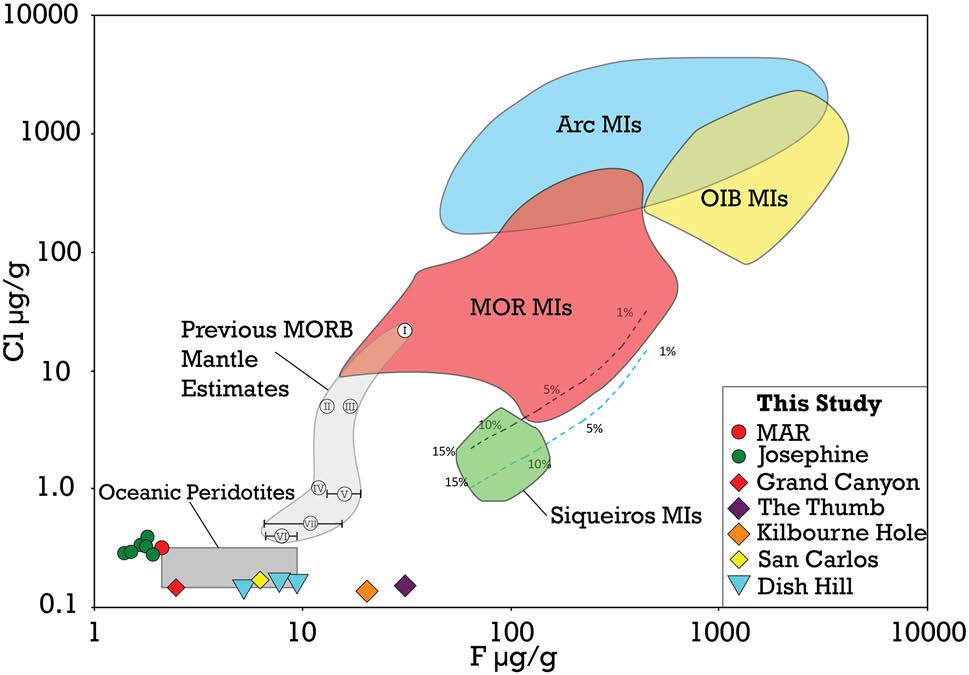
Ben Urann (PhD student in Le Roux’s group) just published his work on SIMS developments and halogen budgets of the Earth’s mantle!
The fluorine (F) and chlorine (Cl) contents of arc magmas have been used to track the composition of subducted components, and the F and Cl contents of MORB have been used to estimate the halogen content of depleted MORB mantle (DMM). Yet, the F and Cl budget of the Earth’s upper mantle and their distribution in peridotite minerals remain to be constrained. Here, we developed a method to measure low concentrations of halogens (≥0.4 μg/g F and ≥0.3 μg/g Cl) in minerals by secondary ion mass spectroscopy. We present a comprehensive study of F and Cl in co-existing natural olivine, orthopyroxene, clinopyroxene, and amphibole in seventeen samples from different tectonic settings. We support the hypothesis that F in olivine is controlled by melt polymerization, and that F in pyroxene is controlled by their Na and Al contents, with some effect of melt polymerization. We infer that Cl compatibility ranks as follows: amphibole > clinopyroxene > olivine ~ orthopyroxene, while F compatibility ranks as follows: amphibole > clinopyroxene > orthopyroxene ≥ olivine, depending on the tectonic context. In addition, we show that F, Cl, Be and B are correlated in pyroxenes and amphibole. F and Cl variations suggest that interaction with slab melts and fluids can significantly alter the halogen content of mantle minerals. In particular, F in oceanic peridotites is mostly hosted in pyroxenes, and proportionally increases in olivine in subduction-related peridotites. The mantle wedge is likely enriched in F compared to un-metasomatized mantle, while Cl is always low (<1 μg/g) in all tectonic settings studied here. The bulk anhydrous peridotite mantle contains 1.4–31 μg/g F and 0.14–0.38 μg/g Cl. The bulk F content of oceanic-like peridotites
(2.1–9.4 μg/g) is lower than DMM estimates, consistent with F-rich eclogite in the source of MORB. Furthermore, the bulk Cl budget of all anhydrous peridotites studied here is lower than previous DMM estimates. Our results indicate that nearly all MORB may be somewhat contaminated by seawater-rich material and that the Cl content of DMM could be overestimated. With this study, we demonstrate that the halogen contents of natural peridotite minerals are a unique tool to understand the cycling of halogens, from ridge settings to subduction zones.
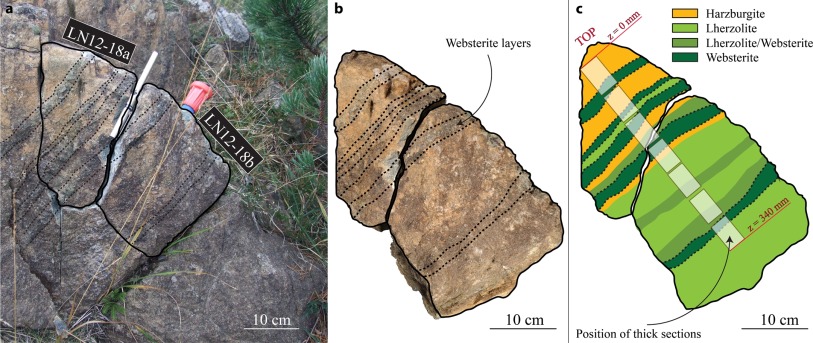
Constraining the scale and the nature of mantle heterogeneities is critical to understand mantle dynamics, but there is still limited information available on the mechanisms and timing of formation of mantle heterogeneities observed in exhumed mantle rocks. Most of those heterogeneities are layered pyroxene-rich veins that form as a result of melt focusing and subsequent melt-rock reactions (Le Roux et al. 2007, 2008, 2009). A critical question is whether those heterogeneities reflect ubiquitous melt-rock reaction processes in the upper mantle, or whether they only form locally at the time of exhumation. Those two hypotheses have drastically different consequences. If mantle heterogeneities in exhumed mantle rocks reflect ubiquitous processes, one can assume that large quantities of melts may accumulate at depth, and not necessarily erupt. On the other hand, if mantle heterogeneities observed in exhumed mantle rocks usually form during exhumation, melt accumulation and melt-rock reaction processes in the mantle may only be local processes. Answering this question requires the ability to constrain the timing of formation of those heterogeneities relative to the age of exhumation in a given massif. In the Le Roux et al. (2016) study funded by NSF-EAR, we present a new method that places solid constraints on the age of layered pyroxenites veins, products of melt-rock reaction in the Lherz Massif. We combine high-resolution trace element profiles, isotope model ages, and diffusive re-equilibration timescales using major and trace element closure temperatures to constrain the formation age of layered pyroxenites in exhumed peridotites. We show that these heterogeneities are 1.5-1.8 Ga old and that their formation of is clearly disconnected from the process of exhumation at ~ 100 Ma. These results are important because they show that melt–rock reactions that lead to the formation of such heterogeneities are not a local process due to exhumation of the mantle, but must rather be widespread and continue to occur at lithosphere-asthenosphere boundaries today.
http://www.sciencedirect.com/science/article/pii/S0012821X16304654
Dec 2015 – New paper in American Mineralogist: Partition coefficients for FRTE during mantle melting

First-row transition element (FRTE) concentrations in primitive mantle-derived melts have been used as direct indicators of mantle source mineralogy (e.g., Ti, Mn, Fe, Co, Ni, Zn) and as proxies to trace the oxidation state of the mantle (e.g., Sc, V, Cu, Zn). Ga and Ge, which share chemical similarities with FRTEs, may also have the ability to trace mineralogical heterogeneities in the source of mantle-derived melts. Although the partitioning behaviors of most FRTEs are well constrained during mantle melting, partition coefficients of Cu, Ga, and Ge between mantle minerals and melt are still uncertain. Here we report new measurements that constrain partition coefficients of Cu, Ga, and Ge between olivine (Ol), orthopyroxene (Opx), clinopyroxene (Cpx), and basaltic melt from graphite capsule experiments carried out at 1.5–2 GPa and 1290–1500 °C. We suggest that discrepancies between recent experimental studies on Cu partitioning reflect one or more of the following causes: compositional control on partitioning, the effect of oxygen fugacity, Cu loss, Fe loss, non-Henrian behavior, and/or lack of complete chemical equilibrium. The partitioning values obtained from this study are 0.13 (±0.06), 0.12 (±3), and 0.09 for DCuOl/melt, DCuOpx/melt, and DCuCpx/melt, respectively. Using values from this study and from the literature, we show that melting of a sulfide-bearing peridotite source with an initial DCu peridotite/melt ranging from 0.49 to 0.60 can explain the Cu content of primitive MORBs. Here, we also support the hypothesis that Ga partitioning between pyroxenes and melt strongly depends on the Al2O3 content of pyroxenes. Using pyroxene compositions from experiments, and previous partition data from literature, we recommend DGaPx/melt values for low-P (1.5 GPa) spinel peridotite melting (DGaOpx/melt = 0.23 and DGaCpx/melt = 0.28), intermediate-P (2.8 GPa) spinel peridotite melting (DGaOpx/melt = 0.42 and DGaCpx/melt = 0.40), high-P (3 GPa) garnet peridotite melting (DGaOpx/melt = 0.38 and DGaCpx/melt = 0.37), high-P (4 GPa) garnet peridotite melting (DGaOpx/melt = 0.26 and DGaCpx/melt = 0.30), and MORB-like eclogite melting at 2–3 GPa (DGaCpx/melt = 0.78). Consistent with previous studies, we find that Ga is incompatible in olivine during low-P peridotite melting (DGaOl/melt = 0.08). Using values from this study and from the literature, we support the hypothesis that the Ga, Ga/Sc, and Ti contents of most mantle-derived melts require garnet in their source, but that additional lithologies (e.g., metasomatic veins) may be necessary to explain the chemical variability of those melts. Here we also obtain Ge partition coefficients applicable to low-P peridotite melting of 0.67, 1.04, and 1.12 for DGeOl/melt, DGeOpx/melt, and DGeCpx/melt, respectively. Last, to provide a comprehensive picture of FRTE, Ga, and Ge partitioning during mantle melting, we provide a complete set of recommended partitioning values, based on results from this study and from the literature, for all FRTEs, Ga, and Ge, relevant for partial melting of spinel and garnet peridotite, as well as for MORB-like eclogite.
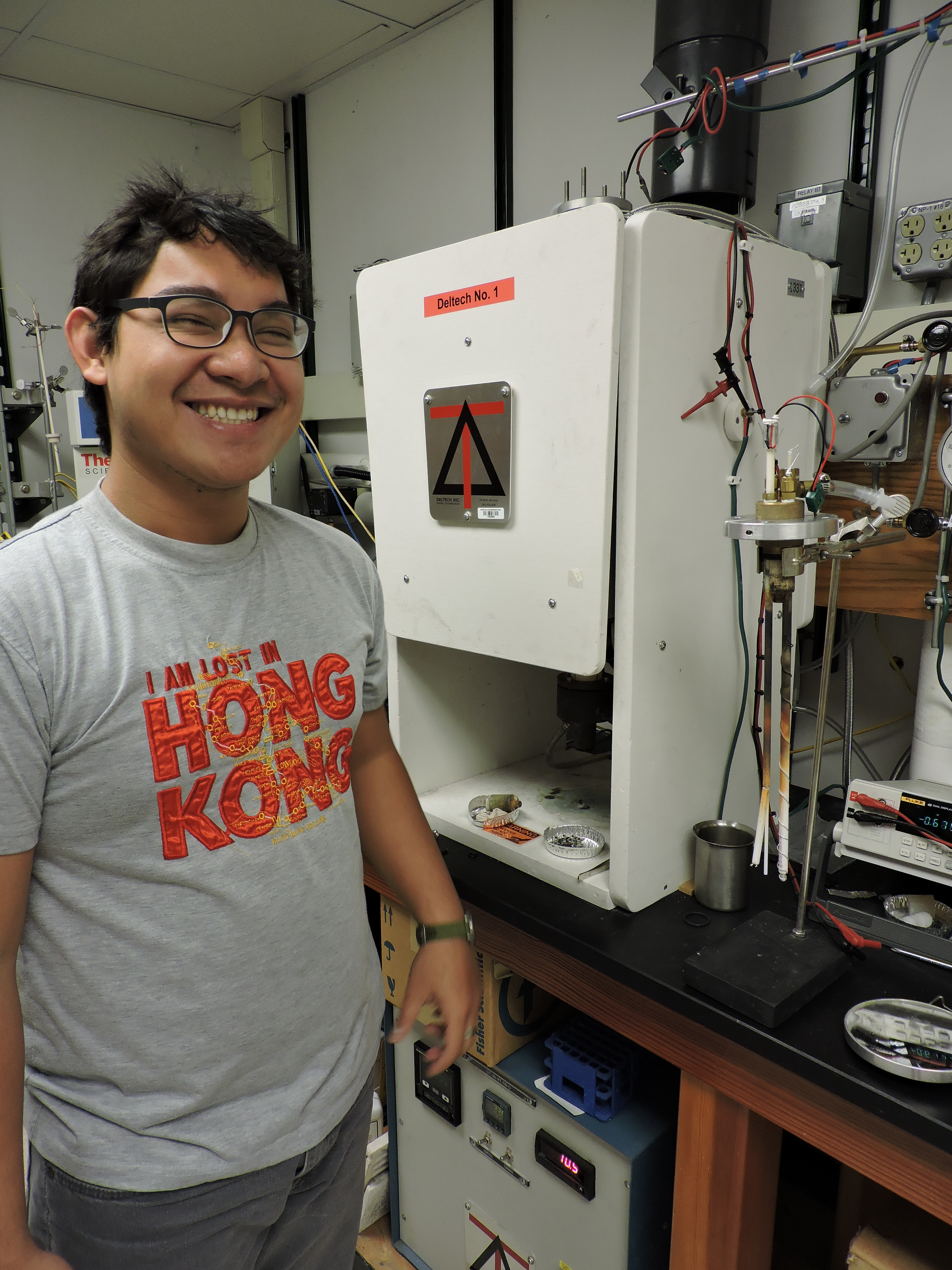
Emmanuel is a master thesis student from the University of Philippines, and a guest student at WHOI until March 2016. He is learning to do experiments to decipher how material is transported from subducted slabs to the source of arc lavas. Welcome Emmanuel!

Emma Soucy comes from Northeastern University (Boston), and is working on calculating temperatures of rocks to understand how our planet Earth has cooled over time. Emma has started in July and has already taken the temperatures of many rocks! Welcome Emma!
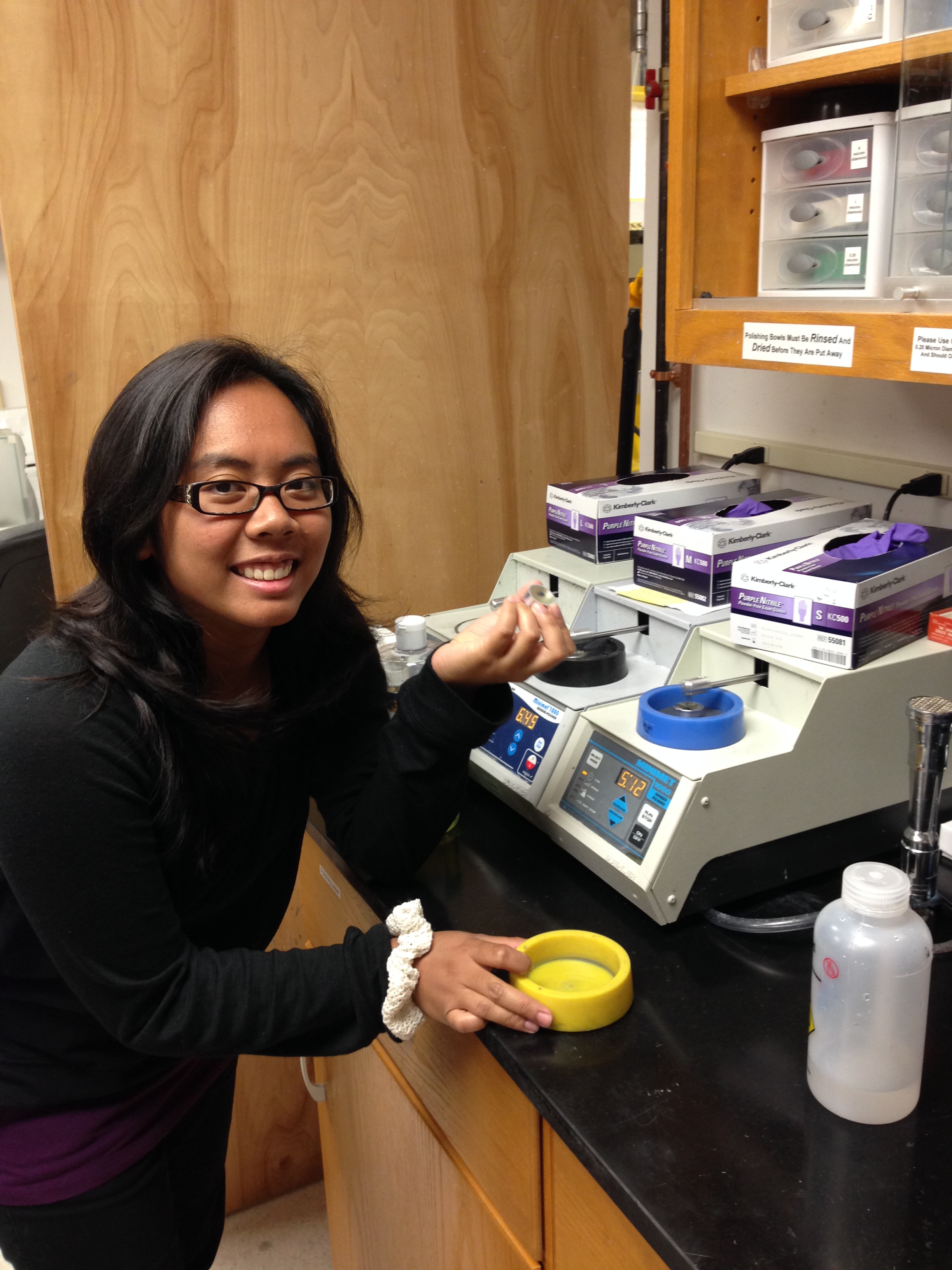
After a successful summer as a PEP student last year, Marienel Basiga (San Jose State University) is back into the experimental laboratory to figure out how slab melts modify the composition of mantle wedges in subduction environments. She is now a prestigious Summer Student Fellow at WHOI!

The skyscan 1272 has safely arrived in le Roux’s lab. The table-top micro-CT instrument can scan objects in 3-D up to 7 cm in height and up to 7 cm in diameter. For small objects (< few mm), highest resolution is 0.45 um.

Gaining research experience led Marienel Basiga, a junior geology major at San Jose State University, to the Woods Hole PEP. Her research project with mentor Veronique Le Roux at Woods Hole Oceanographic Institution, in a field of geology known as experimental petrology, involved measuring grain-scale permeabilities of calcite and quartz through high-pressure, high-temperature experiments to study seawater recycling in the deep earth. “I expected to work hard and be extremely dedicated to the internship, but it surprised me how much fun I am having as well. I rode a bike the whole summer, something I haven’t done since I was 12.” Born in the Philippines, Basiga moved to the U.S. when she was nine and plans to attend graduate school on her way to a position as an academic researcher in some field of geology.
Her hometown is San Jose, California.
Text and image courtesy of Shelley Dawicki, NOAA Fisheries Service
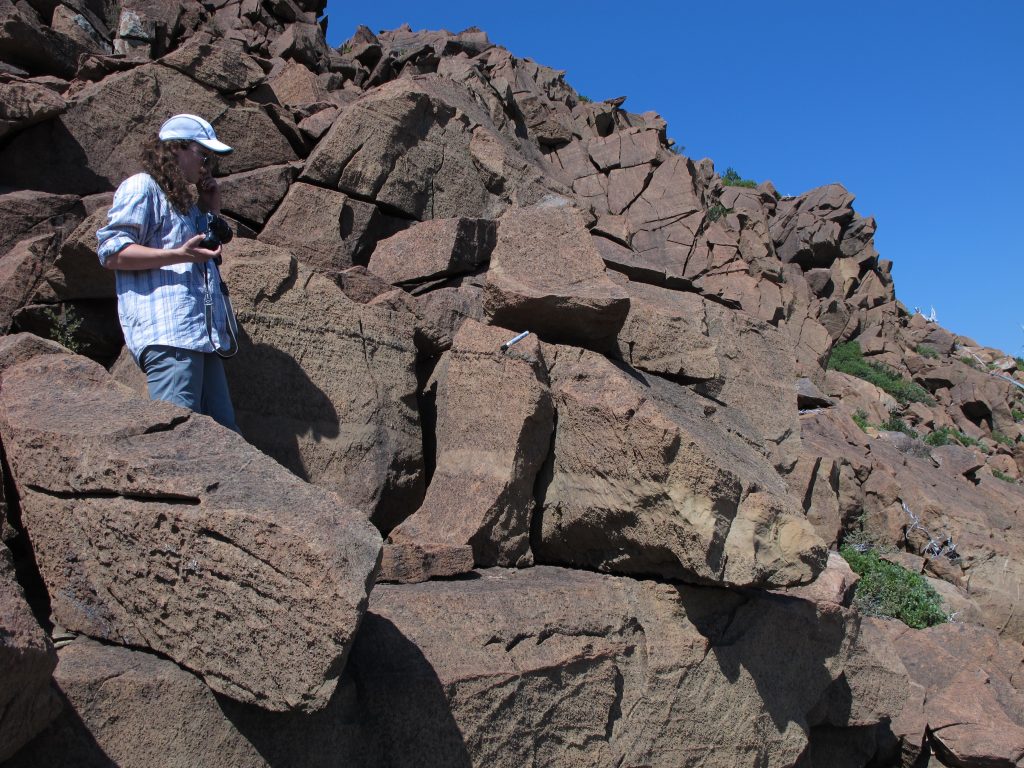
“Tracking flux melting and melt percolation in supra-subduction peridotites (Josephine Ophiolite, USA)” is now In Press for Contributions to Mineralogy and Petrology.
Abstract
Here, we investigate the scale and nature of melting and melt percolation processes recorded by 17 supra-subduction peridotites collected in a ~70 km2 area in the northern portion of the Josephine ophiolite (Western USA). We present major and trace element variations in whole rocks; major elements in olivine, orthopyroxene, clinopyroxene and spinel; and trace elements [including rare earth element (REE)] in clinopyroxene and orthopyroxene. In the Josephine peridotites, compositional variability occurs at different scales. On the one hand, large systematic changes from depleted to fertile peridotites occur on large kilometer scales. Field, petrological and geochemical data can be consistently explained if the Josephine mantle experienced variable degrees of hydrous flux melting (10 to >20–23 %), and we argue that small fractions of subduction-derived fluids (0.015–0.1 wt%) were pervasive in the ~70 km2 studied area, and continuously supplied during wedge melting. Fluid localization probably led to increased extent of flux melting in the harzburgitic areas. On the other hand, in single outcrops, sharp transitions from dunite to harzburgite to lherzolite and olivine websterite can be found on meter to centimeter scales. Thus, some fertile samples may reflect limited degrees of refertilization at the outcrop scale. In addition, clinopyroxene and orthopyroxene in ultra-depleted harzburgites (Spinel Cr# > 58) show variable degrees of LREE enrichment, which reflect percolation of and partial re-equilibration with, small fractions of boninite melt. Because the enriched samples also show the highest spinel Cr#, we argue that these enrichments are local features connected to the presence of dunite channels nearby. Lastly, trace element concentrations of pyroxenes in Josephine harzburgites show that they are one of the most depleted harzburgites among worldwide ophiolitic peridotites, indicating particularly high degrees of melting, potentially past the exhaustion of clinopyroxene.
Authors: V. Le Roux, H.J.B. Dick, N. Shimizu
